In Sept 2015, my wife and I made it down to the On Target Shooting range in Jacksonville Florida and it was an action packed and very worthwhile visit. Although we had to battle through rain in our rather lovely (long story) Dodge Challenger Hemi on the beltway, rain that was almost biblical and a Sat Nav that clearly didn’t know how to find the address, we eventually got to the range and the staff didn’t waste any time getting us prepared and up and shooting quickly. The bill for the first day (150 x 9mm parabellum rounds, rental of one Glock 17 ($12) and a preparatory lesson was, all in $150)
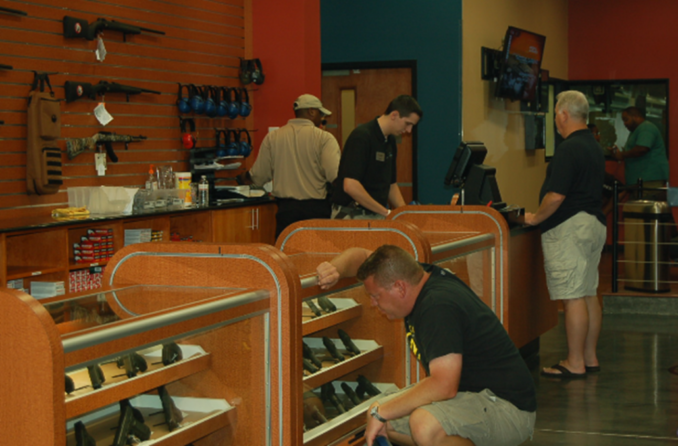
Very early on when exploring the entirely theoretical subject of hand guns for personal defence in the UK, I’d discounted any notion of working with wheel revolvers, based on a personal preference for the ease of semi automatic magazine swaps and a technical dislike of the loss of energy from the gap between a revolvers chamber and its barrel. Some folks swear by revolvers – and in their defence they are far less likely to jam than a semi automatic pistol (and if the round fails to fire, you simply pull the trigger again)… but I’d definitely choose a semi automatic any day. With the preparatory work that I’d done in the UK to gain familiarity with Glock pistols on paper I’d managed to define objectives for what I wanted to achieve with a limited number of range visits. I wanted to compare semi automatic firearms in two different calibres 9mm and 45 ACP and across four specific guns. For 9mm I wanted to assess the Glock 17 and the Sig Sauer P226 and for the larger 45 ACP calibre I wanted to assess a Colt 1911A1 (the model resulting after modifications in the year 1912) and a Glock 21. Part of my objective was to find out if stance and sighting lessons I’d worked on at my air gun club over the last year with air rifles and pistols would translate when using firearms. I also wanted to refine any stance or positional failings on my part when grouping shots with these more powerful weapons and to compare and understand the safety mandates on the range (which as it turns out, are virtually identical to an air range)
Paper research is one thing, but handling a firearm for the first time is by far the best way to get a real hands-on sense of how it works. Range rules in Florida mandate that a new member must attend an obligatory safety discussion before doing any shooting and our first range tutor Howie was a patient, knowledgeable and good teacher through the whole of this familiarity lesson.
I liked him immediately.
The range has an important rule which directly affected me, given I was renting guns – namely they do not allow a shooter to rent and shoot solo – so bringing a colleague, a friend or perhaps SWMBO is the way to go. Rental guns are brought to and returned from the gun table of your designated lane (see below) by the range officer who must also be present while you shoot. Other than firing, the gun shouldn’t be moved from the gun table (magazines are brought to the rear bench for filling either by hand or using a filling tool). To enter the range area from the shop, you pass through a secure two door air lock style holding area wearing ear defenders and safety glasses (and believe me if the shooter in a neighbouring lane happens to be using a shotgun, ear defenders are essential). If you run out of ammunition, you simply make your gun visibly safe and leave it down on the firing table and then step out through the security doors to the main desk to order more boxes of rounds (something I had to do numerous times). When finished you make the gun visibly safe with the magazine removed and then signal your intent to the range officer – at which point you can step out through the security doors, wash your hands and settle your account.
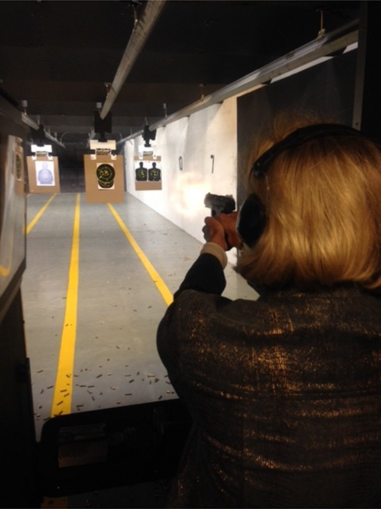
The gun must only ever be loaded and ready to fire when it is on the firing line. At all other times it must be visibly safe (magazine out and slide locked back). While handling a weapon, it is important to always keep the barrel pointing down range and to ensure that your finger is outside the trigger guard – as demonstrated while handling a low power humble Gamo PT85 air pistol. Waving a weapon will quite rightly see you ejected from the range.
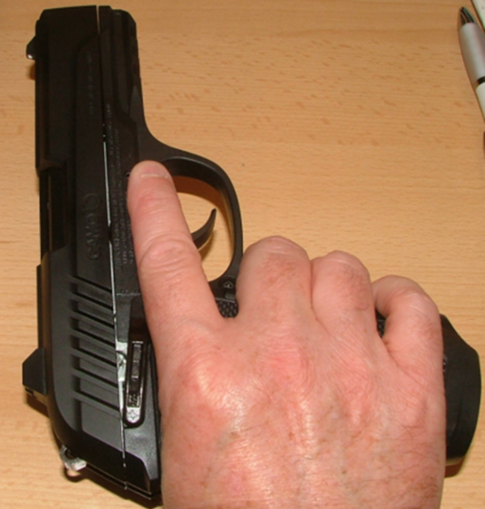
Range officers are present at all times and can call a halt to firing for any reason – something they do by voice alone… loudly. Once called, you must immediately stop firing and make the firearm visibly safe. This is why you need to understand how to deal with that step.
Visually checking the firearm is safe…
For revolvers the wheel can either be rotated open or the barrel broken depending on the style. The range officers will then visibly check each lane until they are satisfied that the range is clear.
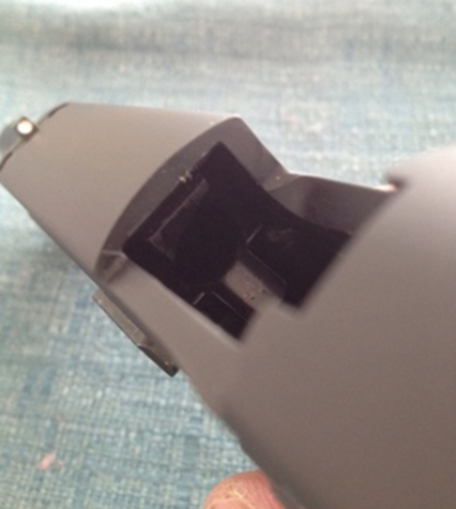
Unlike the air gun club there is rarely a need for anyone to step onto the range – but for example during a gun jam I experienced with a 1911A1, a single live 45 ACP round that I had ejected fell onto the floor and rolled into the range area (beyond the firing line).
I let the range officer know and at a quiet point in the proceedings he called a halt in order to retrieve it.
For targets, you staple your chosen paper target onto a cardboard sheet connected to the lane motor drive and use a touch screen lane control system (see below) to set the target position down range.
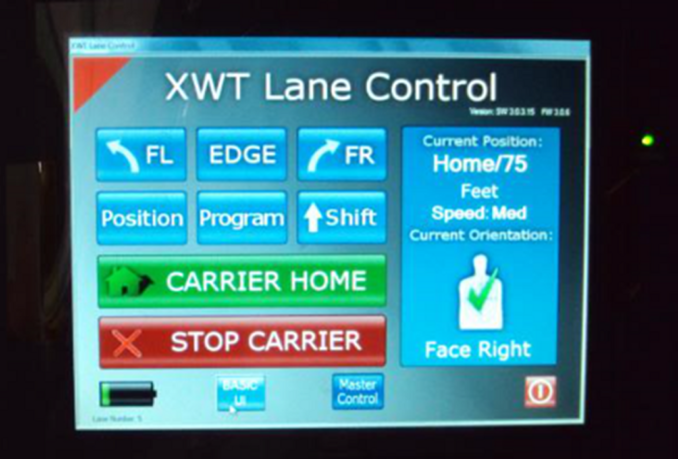
Hit “Carrier home” to bring the target back to you, otherwise hit the “Position” button, and enter the range you wish the target to be from you, in yards or feet – and the motorised drive will move a paper target accordingly. It is safe and extremely easy to use.
Armed with ear defenders and safety glasses and with a Glock 17 awaiting us on the gun table in lane 5 – my wife and I made our way into our very first shooting range.
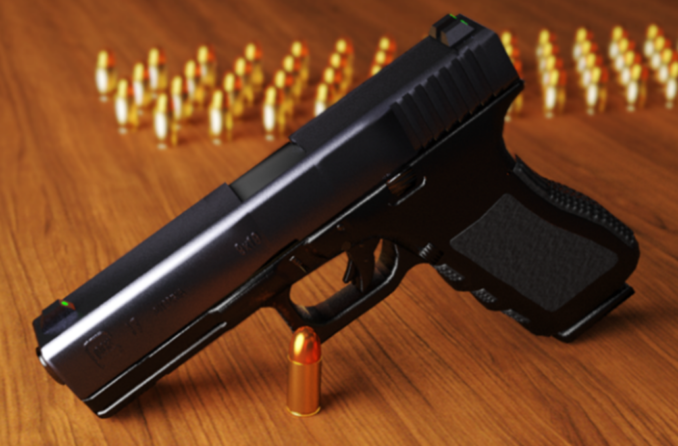
The Glock 17 generation 4 is a single action semi automatic firearm with a magazine capacity of 17 rounds. One of the first steps is to fill the magazine with rounds… and you’ll find plastic tools on the range that will make that process easier. Starting from a position where the gun is visibly safe (slide locked back, magazine out), insert the magazine and release the slide lock – at which point the slide returns home carrying the first round into the barrel. This process also cocks the firing pin at which point the gun is hot and ready to fire. On the other hand, if (like me) you receive the empty gun with the slide is in its normal (battery) position, insert the magazine, pull back the slide and let it go to make the gun hot. This is the significance of a Glock being a single action gun (one that is also technically referred to as a striker fire gun). The trigger can not fire the weapon until after the gun has been cycled either manually or automatically one time to load a round into the barrel and cock the striker firing pin. Until that step takes place, the trigger will do nothing at all.
A hammer fire, double action weapon such as a Sig P226 is quite different in this regard
The trigger on a Glock is a different from most semi automatic firearms as it is arranged as one trigger but which has a smaller sub trigger built in – and which taken together are referred to as Glocks “Safe action” trigger.
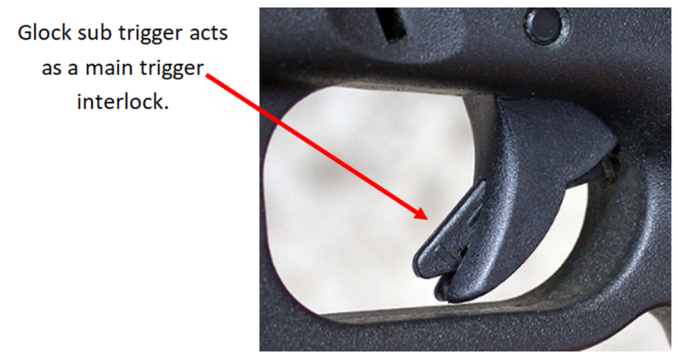
The sub trigger is simply a mechanical interlock, designed so that unless you have you full finger holding the sub trigger down as you pull the larger main trigger, the gun won’t fire.
By contrast, the Colt 1911 has a different interlock, requiring the web of the hand to be firmly holding the butt of the gun (at the rear and just immediately under the slide) before it can fire… that interlock makes sense because the 1911 was originally designed for cavalry use and if you picture taking the gun out of the holster while bumpily riding a horse, you can understand why John Moses Browning (God bless him) sought to prevent the rider accidentally demoting themselves to a humble foot soldier. The interlocks for both the Glock 17 and Colt 1911 offer no advantage when actually using the weapon – but they do help prevent accidental discharges if the gun is either rough handled or dropped.
My wife and I both ended up shooting three boxes of ammunition (150 rounds) at two paper targets. My wife found it slightly harder to sight for good shots but with the help of another staff member (Charlie) she ended up getting shots in a hand sized group at 7 yards which was good. She was also disadvantaged at the time (I’m kicking myself that I didn’t think about this when we left the house) because of the top and the flip flops she was wearing, which offered no protection from the spent and therefore hot casings ejected from the slide. The other issue she struggled with was eye sight – as she struggled to see where the rounds landed at the precise point of firing – and as I’ve learned with air rifles you must establish the landing point in order to zero your eye with the gun sights… a process that is somewhat more tricky with a firearm due to the natural tendency to blink at the point of firing.
For myself, I’d explained my background to the staff in various emails and also to Howie in the safety briefing (zero experience with firearms, some years of club based air gun experience) – but I (and he) were both genuinely surprised at how much the safety, handling and target skills I’d honed with low power air rifles translate almost entirely to firearms. The areas that don’t cross over are the muzzle lift natural to any firearm and the linked recoil anticipation of the shooter (explained later… keep the word “flinch” in mind – because it can become a big problem for new shooters, as it did for me). But from the start with the Glock, I could obtain roughly 4″ groups at 5 yards and 5″ groups at 7 yards which for my first attempt at shooting was I think reasonably good. Put it this way, an entirely unconnected shooter in the next lane to ours was also firing a 9mm semi auto and as I discretely watched his progress, at 5 yards he was struggling to get better than a 12” group.
This illustrates an interesting difference between air guns and firearms. With my most powerful legal limit and heavily customised air pistol, it takes me typically 7 shots to knock over 5 targets with a diameter of something like 2.5” at roughly 25 yards and I can obtain penny sized groups at 35-40 yards with my Air Arms S410 air rifle. There are experienced folks at the air gun club who can shoot with vastly more precision than I – but that’s the interesting thing… the degree of accuracy demanded by a good UK air gun shooter is remarkable compared to the accuracy required when using firearms for self defence. Obviously hand guns have infinitely more knock down (also more recoil)… but because most US citizens generally intend them to be used for self defence, people at the range are taught quite specifically to practice at a distance similar to the length of the average house hallway (5 to 10 yards max) and at paper targets showing torsos and head outlines. The prime targets being mid body torso shots while secondary targets include headshots and lower side shots (left and right).
Regarding the Glock – if I’m honest, I’ve always really liked the technical elegance of this striker fired weapon while recognizing that they are, shall we say, boxy and ugly. Glock was the first company to employ a polymer receiver to reduce weight and the guns do have a truly enviable safety record – but after using one, and given the option to purchase, I’d look elsewhere. One downside with the Glock is the spread pattern of ejected spent shells, which all too often end up in your face (hitting safety glasses), shoulders and/or arms. In addition the sights are fixed on the slide and on the club gun we used, they were dreadfully inaccurate requiring a huge holdover to reliably hit targets. Glocks are also single action guns with no double action facility from the get go – a limitation you can better appreciate after using a gun such as the Sig Sauer P226. A Glock is good in the sense that they are light, reliable, safe and simple, but in my opinion there are better hand guns out there.
After that first visit and speaking personally, it was a heck of an experience for this hemmed in, frustrated, UK peasant who, thanks to the USA… got an opportunity to exercise a US citizens right to bear arms.
Naturally, as soon as my wife and I land on the tarmac at Heathrow, we are no longer considered trustworthy by our government and so everything we did today is immediately punishable by a mandatory 6 to 10 year prison term with no right of appeal. This is in all regards bewilderingly bizarre and all the more so speaking as someone who prides themselves on being scrupulously law abiding.
Brilliant day – and my grateful thanks to the USA…
Coming soon – Part III covering flinch and techniques such as dry firing cycles and using ball-&-dummy to combat that problem, along with the superb Sig P226 9mm weapon and also larger 45ACP calibre weapons… because sometimes slow and heavy will get the job done.
© text & images Verax Cincinnatus 2020
The Goodnight Vienna Audio file



